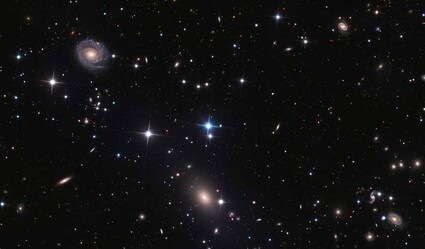Stars over Sisters 6/03/2020
Last updated 6/2/2020 at Noon

courtesy Adam Block/Mount Lemmon SkyCenter/University of Arizona
Spiral galaxy NGC 6085 in the upper left and elliptical galaxy NGC 6086 lower center of photo highlight a number of more distant galaxies in the constellation of Corona Borealis.
As the arrival of summer is just around the corner, it is not unreasonable to expect warmer weather to be a more frequent visitor to Central Oregon. Accompanying the more comfortable temperatures are changes in our night sky. So, while you’re enjoying a slice of early season watermelon way past your bedtime, don’t forget to go outside and look up — for you might see something amazing.
Constellation families are groups of constellations that are either located in the same area of the sky, associated with the same myth or theme, or were created at the same point in history. The featured constellation for June is one of 10 other stellar groupings of the Ursa Major Family, namely Corona Borealis, which is bordered by Hercules, Serpens and Boötes.
Six of the constellation’s brightest stars form a semicircle known as the Northern Crown. Alphecca is the brightest star, glowing at an apparent magnitude of 2.23. On the magnitude scale, the lower the number, the brighter the star. Alphecca is an eclipsing binary that lies at a distance of approximately 75 light-years. Nusakan, the second brightest luminary in the group at magnitude 3.28, is a spectroscopic binary located 114 light-years away.
There are few deep sky objects in the constellation within range of telescopes owned by most amateur astronomers. But it does contain the Corona Borealis Galaxy Cluster. This cluster is comprised of about 400 galaxies in one degree of the sky. It is located between 1 to 1.5 billion light-years from the earth.
In Greek legend Corona Borealis is connected to the myth of Princess Ariadne of Crete. The ring of stars that denote the crown was worn by Princess Ariadne when she married Dionysis. Princess Ariadne is known for helping Theseus slay the Minotaur who was Ariadne’s half-brother. The king banished the Minotaur to a labyrinth from which no one could escape.
When Theseus came to Crete, he was put in the labyrinth for the Minotaur to eat. But Ariadne fell in love with Theseus, so she gave him a spool of string to bring with him as he went through the labyrinth. Once he slew the Minotaur, he followed the string out. After his escape, he and Ariadne sailed away from Crete. Shortly thereafter, however, Theseus abandoned her on the isle of Naxos. Dionysis found Ariadne weeping on the island and they soon fell in love and married.
Summer officially begins in the Northern Hemisphere at 2:44 p.m. on Saturday, June 20. At that time, the earth’s axis of rotation will tip toward the sun, causing the noonday sun to lie directly overhead at the Tropic of Cancer. The result is the longest period of daylight hours of the year; not good news if you’re wanting to get some evening observing done before bed, particularly when you throw Daylight Saving Time into the mix.
Of the five naked-eye planets, only elusive Mercury occupies the evening sky this month. On June 4 the diminutive planet lingers above the western horizon a full two hours after the sun has set. However, by mid-month Mercury will be harder to spot as it sinks ever closer to the sun.
The two biggest planets in the solar system, Jupiter and Saturn, will rise just after midnight this month. They currently reside near the border of Sagittarius and Capricornus. Both will become evening planets next month. Mars rises after 2 a.m. local time on June 1, an hour earlier by month’s end.
After completely dominating the evening celestial stage with its brilliance over the past several months, Venus reaches inferior conjunction on June 3. It will emerge in the morning sky later in the month.
The Full Strawberry Moon occurs on June 5. The “strawberry moon” got its name from Native Americans in eastern North America when they began harvesting ripening wild strawberries in June. After this date, the face of the moon becomes progressively less illuminated before going dark on June 20. A waxing moon is in play for the remainder of the month.
















Reader Comments(0)